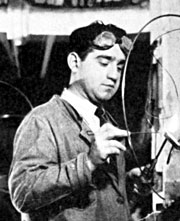
Enio Girola was born in Rosario on March 20, 1926. His family moved to Buenos Aires during his early youth. He became related to the Plastic Arts when he learned to work on metals at his father’s craft studio. In 1945 he created his first concrete sculptures and, the following year, he was one of the charter members of the Asociación Arte Concreto-Invención. In 1946 he signed the Inventionist Manifesto, together with his brother Claudio Girola, Lidy Prati, Tomás Maldonado, Raul Lozza, Manuel Espinosa, Edgar Bayley, Alfredo Hlito, Oscar Núñez, and Jorge Souza, among others.
By the early ‘50s, he used different materials – wire, aluminum, stainless steel, bronze - in the series Directional Sculptures, Linear Continuities and Space Constructions.
In 1952 he became a member of the Group of Modern Artists of Argentina, with Hans Aebi, José Antonio Fernández Muro, Claudio Girola, Sarah Grilo, Alfredo Hlito, Tomás Maldonado, and Miguel Ocampo.
In 1958 he took part in the International Exhibition of Brussels. In 1960, he represented Argentina to the II International Exhibition of Concrete Art at the Kunsthaus, Zurich. The following year he took part –out of competition - in the VI International Biennial Exhibition of San Pablo, and in 1964 his works were included in the Argentine lot sent to the Biennial Exhibition of Venice.
In 1969 he participated in the I Biennial Exhibition of Nüremberg.
Invited by the Italian government, in 1968 he traveled through Italy, Switzerland, England, the United States, and France, where he created two sculptures for the city of Cannes. By that time his works underwent a process of change and, in 1971, he had an exhibition, One Line, One Space at the Carmen Waugh Gallery. It consisted in an area crossed by tightened cables generating virtual and real spaces, which the spectator had to traverse.
In 1977, under the title Adiós a una época (Good bye to An Age), he had an exhibition at the Galería del Retiro expressing a twist in his poetics. The works of this stage included not only acrylic, metals, marbles, stones – customary materials in his production – but also all types of waste that enabled him to show some contradictions of modern life.
Among his most recent individual exhibitions, the Retrospective Exhibition 1945/1980, at the Museo Eduardo Sivori, 1980, can be mentioned as well as Ten Years After the Sculptural Change, Julia Lublin Gallery, 1987; Para no caer en toques artesanales (So As Not to Fall in Craftsmanship Strokes), Instituto de Cooperación Iberoamericana (ICI), 1994; Enio Iommi, esculturas dos momentos (Enio Iommi, Sculptures Two Moments, Filo Espacio de Arte, 1996; El espacio como forma (Space as A Form), Ruth Benzacar Gallery, 1997, also exhibited in Rosario the following year; Mis utopías versus la realidad (My Utopias Versus Reality), Ruth Benzacar Gallery, 1999; and the anthological exhibition hosted by the Centro Cultural Recoleta in 2001.
In 1975 Iommi was appointed Number Member of the Academia Nacional de Bellas Artes. He resigned in 1999.
He took part in the main exhibitions held outside the country that dealt with the development of abstraction in the Rio de la Plata, among them Argentina, Arte Concreto Invención 1945, Grupo Madí 1946, at the Rachel Adler Gallery, New York (1990); and Abstract Art from the Rio de la Plata, Buenos Aires and Montevideo 1933/53, at The Americas Society of New York (2001).
Several of his sculptures are located in public and private spaces - a house designed by Le Corbusier, in the city of La Plata (1954); the Teatro San Martín (1960); the College of Architecture in Valparaiso (1967); the gardens of the Museo Nacional de Bellas Artes (1977); the Sheraton Hotel Buenos Aires (1972); the Prado de Esculturas of the Baconao Park in Havana (1985); the Park of Aji, Shikoku Island, Japan (1987); the Marinha Park, Porto Alegre (1988); and the International Park of Sculptures, Museum of Art, Brasilia (1998).
He dies in San Justo, Buenos Aires Province, on May 13. 1980.